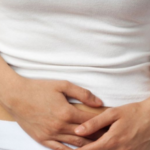Nutrition rules for umbilical hernia
Treatment of umbilical hernia in adults is carried out exclusively by surgery. Conservative therapy is prescribed before and after the operation, and in order to increase its effectiveness, it is extremely important to change the diet, limit the use of certain foods and follow the regimen prescribed by the doctor. A protrusion in the navel is accompanied by digestive disorders, because in the hernial sac in most cases there is an intestinal loop.
A diet for an umbilical hernia is needed in order to exclude factors that lead to an increase in intra-abdominal pressure: constipation, bloating, stomach fullness.
Such conditions can lead to complications, because excess pressure provokes even more bulging of organs, which can be infringed at any time. Pinching is a dangerous condition, because it ends with necrosis of organs such as the intestines, omentum, and stomach.
In children, this disease is much more common and it manifests itself from birth or some time after cutting the umbilical cord. And if everything is clear with the nutrition of infants, then with a hernia in adults, the choice of diet should already be given more attention.
Nutrition for hernia
An umbilical hernia occurs predominantly in women who have had a difficult birth. Excess weight will also be a risk factor for the disease, when muscle tissue is replaced by fat, and there is excess pressure on the anterior abdominal wall. In men, this disease is associated with physical activity.
The risk of pathology is higher in people involved in power sports and heavy work involving heavy lifting.
A hernia can occur at one moment with a sharp increase in intra-abdominal pressure. In addition, there is a possibility of infringement immediately from the moment the protrusion appears. In the first case, conservative treatment is considered, but surgery is planned. When the hernia is immediately infringed, an urgent surgical intervention is performed.
Dietary nutrition and moderate physical activity are not only important stages of treatment, but also the prevention of umbilical hernia, when there is a predisposition to it.
About the general rules of nutrition for a hernia of the umbilical ring in adults:
- frequent meals (4 or more times), but in small portions (150-250 ml each);
- exclusion of overeating and quick snacks with "harmful" foods;
- refusal of alcoholic beverages;
- limiting foods that cause constipation and bloating;
- gradual rejection of fatty and fried foods;
- drinking plenty of fluids between meals.
Obesity is a factor in the progression of umbilical hernia, therefore, with excess weight, the diet should also contribute to weight loss.
Diet for hernia in adults
Medical nutrition can be prescribed by a doctor after the removal of a hernia of the abdomen, but a soft diet is always needed, regardless of the period of the disease. Its purpose will be to prevent high pressure inside the peritoneum. After surgery, a therapeutic diet will be needed to minimize pressure on the surgical area.
Prevention of complications due to diets is achieved by:
- reducing the time of digestion of food;
- fractional nutrition;
- exclusion of heavy foods;
- prevention of bloating and constipation.
Nutrition for hernia is not universal, the diet is selected taking into account the characteristics of the body. With a tendency to bloating, the consumption of foods rich in dietary fiber (fiber) should be minimized. When frequent constipation is observed, it is necessary to limit astringent dishes, which will be rice and pea porridge, dried fruits, strong tea.
To prevent bloating, limit the use of the following foods :
- corn, peas, legumes;
- carrots, potatoes in their skins, asparagus;
- apples, grapes, plums;
- soy, beans.
Partially , you need to remove foods with a low fiber content:
- white bread, pies, pastries, cakes;
- fatty meat, milk, butter;
- white rice, noodles;
- fruit juices, teas.
Contraindications
The diet for hernia in adults excludes the following products:
- sweet carbonated drinks, dried fruit compote, pear juice, kvass;
- seasonings and spices, salt and sugar are acceptable in small quantities;
- fresh white bread, pastry, pastries;
- sinewy meat, fish broths, mushroom broths, smoked meats and canned food;
- wheat porridge, pearl barley, pasta;
- legumes, some vegetables (turnip, cabbage, radish).
Healthy foods
Recommended products for hernia in adults:
- lean beef, pork, chicken dishes, steamed turkey;
- potatoes, zucchini, cauliflower, pumpkin, beets;
- cottage cheese, puddings, casseroles;
- chicken and quail eggs;
- dairy products (in the absence of bloating);
- fruits without coarse fiber, kissels, fruit purees;
- oatmeal, buckwheat porridge in water and milk, when there is no constipation;
- refined sunflower oil;
- vegetable juices, weak milk tea, rosehip decoctions, chamomile.
Diet
Strict restrictions can be in the first weeks after the diagnosis of pathology, and after surgery. The diet expands gradually, while the patient monitors his well-being, and removes foods that cause unpleasant symptoms.
Sample menu for the day:
- Breakfast includes light cereals with water or milk, tea, chicken egg.
- The second breakfast should consist of vitamin and hearty food, it can be cottage cheese, cheese, vegetable puree, fruit juice.
- Lunch consists of soup with vegetables, salad, white meat.
- The afternoon snack is light, includes a fruit salad or a casserole.
- Dinner should be hearty, but not heavy, you can eat fish cakes, green peas, squash puree, drink sweet tea or kefir.
Such a diet is sparing for the stomach and the entire gastrointestinal tract, the listed products exclude bloating, which will already be an important step in the prevention of complications of umbilical hernia. The disadvantage of such a diet will be the restriction of carbohydrates, which can be difficult for the body to tolerate.
Diet after surgery
The first days after hernia repair, liquid nutrition is indicated. The patient can eat soups, broths, cereals on the water. From the liquid it is recommended to drink only clean water. Gradually slimy soups, vegetable decoctions are added to the menu. If there are no complications, after three weeks you can return to your usual diet, but taking into account all the recommendations for a healthy diet.
About the general rules of nutrition after removal of an umbilical hernia:
- Before meals, take a teaspoon of unrefined oil for normal intestinal patency.
- Eat regularly without long breaks, avoid hunger.
- Reduce the amount of solid food you eat.
- Exclude foods that increase the acidity of gastric juice.
Diet for both umbilical hernia in adults and any other will be important for the normal functioning of the gastrointestinal tract.
Useful dishes for normal recovery will be:
- dietary buckwheat soup with vegetables;
- steamed fish and chicken cutlets;
- stewed and boiled vegetables;
- vegetable and fruit salads;
- baked beef and veal.
Dairy products are useful, but far from being allowed for everyone with an umbilical hernia, because fresh milk can cause indigestion, and this phenomenon is highly undesirable in such a pathology. This also applies to fresh vegetables. When compiling the menu, it is necessary to take into account not only the usefulness of the products, but also their tolerance by the body.
If some dietary dish worsens your well-being, you need to abandon it and replace it with another, because the choice of products allowed for hernia is great.
Consequences of a hernia in adults
The main danger of a hernia is the infringement of its contents, and this can also happen due to malnutrition. Overeating, constipation and bloating lead to an increase in intra-abdominal pressure, which causes even more bulging of organs into the hernial sac.
First, there is an expansion of the hernia gate, then their sharp compression, and this leads to compression of the organs, necrotic processes and inflammation begin. At the same time, the patient feels acute pain, there may be vomiting with blood, the stomach increases in volume, the muscles become tense, the hernia ceases to be reduced.
The process of incarceration of a hernia can be compared to how a tourniquet is applied. This can be done for no more than 2 hours, after which the violation of blood circulation leads to irreversible processes.
The smaller the hernia, the higher the risk of pinching. But giant hernias often lead to such a complication, especially when there are several intestinal loops or even all abdominal organs in the hernial sac.
Without surgery, and the choice in its favor always remains with the patient, the hernia gradually increases, and if the hernia repair is postponed, there is a violation of the function of the internal organs. Not only the structures located in the area of the defect suffer, but also the surrounding tissues.
The infringement is insidious in that after some time the pain disappears, and even more so if you take painkillers, but this does not stop the squeezing of the organs, the outcome is always the same - tissue death without the possibility of recovery. This problem is eliminated surgically, partial excision of tissues or complete removal of the organ is performed.
Prevention of complications
Pinched hernia and other consequences can be prevented, and the main measure is surgery. But when there are temporary contraindications, it is important to wear an umbilical bandage, limit physical activity, eliminate risk factors in the form of muscle tension, overeating, excess weight.
In adults, a hernia of the umbilical ring will be an absolute indication for surgical treatment, and more often, in order to remove the protrusion, the hernioplasty method with the installation of a mesh implant is used. The latter will securely fix the area of the defect, preventing the exit of the abdominal organs through it. Without surgery, serious complications can be encountered at any time.










